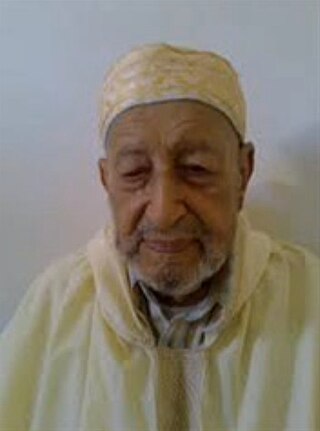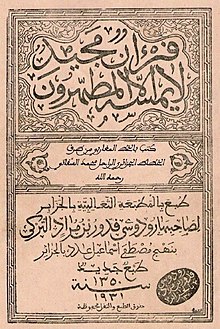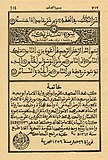Abdul-Rahman al-Tha'alibi was an Arab Scholar, Imam and Sufi wali. He was born near the town of Isser 86 km south east of Algiers. He was raised in a very spiritual environment with high Islamic values and ethics. He had great interpersonal skills and devoted his entire life in service of the most deprived, to dhikr of Allah, and to writing of over 100 books and treatises.
Sidi Boushaki or Ibrahim Ibn Faïd Ez-Zaouaoui was a Maliki theologian born near the town of Thenia, 54 km (34 mi) east of Algiers. He was raised in a very spiritual environment with high Islamic values and ethics within the Algerian Islamic reference.
The Algeria Quran is a Quranic manuscript (mus'haf) written in Algeria with the Kufic script, written according to the Warsh recitation in 1977 by Mohamed Cherifi.
Thaalibia Publishing is an Algerian publishing house based in Algiers and founded in 1895. It publishes books in religion, Sufism, literature, nationalist thought, and art as well as culture. Thaalibia Publishing had a wide distribution network within Algeria and North Africa.

The post of Mufti in Algiers, or Shaykh al-Djazaïr, has been filled by a member of the Maliki and Hanafi ulema, the religious scholars, of Algiers, within the Algerian Islamic reference.
Ahmed Zouaoui was born in Algiers. He was a theologian and Maliki Mufti of Algiers.

Thaalibia Cemetery or Abd al-Rahman al-Tha'alibi Cemetery is a cemetery in the Casbah of Algiers in the commune of the Casbah of Algiers. The name "Thaalibia" is related to Abd al-Rahman al-Tha'alibi.

The Hizb Rateb is a collective recitation of Quran or dhikr or dua or wird done by murids and saliks in islamic sufism.

The Zawiya Thaalibia or the Sidi Abd al-Rahman al-Tha'alibi Zawiya is a zawiya in the Casbah of Algiers in the commune of Casbah in Algeria. The name "Thaalibia" relates to Abd al-Rahman al-Tha'alibi.

The Zawiyas in Algeria are religious buildings located in Algeria honoring the memory of patron saints and dedicated to Quranic and religious education. They are affiliated with Sufi Torouq brotherhoods under the supervision of the Ministry of Religious Affairs and Endowments in accordance with the precepts of the Algerian islamic reference.
The Warsh recitation or riwāyat Warsh ʿan Nāfiʿ' is a qiraʿah of the Quran in Islam.
The Algerian Islamic reference is the fundamentalist and legal framework for the practice of the religion of Islam in Algeria within Sunnism under the tutelage of the Ministry of Religious Affairs and Endowments.

The Hezzab is the hafiz or qāriʾ supervising or participating in the Hizb Rateb in mosques and zawiyas in Algeria according to the Algerian Islamic reference under the supervision of the Ministry of Religious Affairs and Endowments.
The Uthman Taha Quran is a Mus'haf written with the Kufic script by the calligrapher Uthman Taha according to Warsh recitation and other recitations.

Sufism is considered as an essential part of Islam In Algeria. Sufism was fought and oppressed by the Salafists, and now is again regaining its importance as it was there before Algerian Civil War. Sufis have a considerable influence on both urban and rural society of Algeria. Sufism is the part of Algeria as long as 1400 years ago, so recognised as "Home of Sufi Marabouts". Most of the people in Algeria are the followers and murids of Sufism. Sufism has shaped Algerian society and politics for much of the country's history. Today, very few are aware of this legacy. Might the Sufis now provide an important contribution to the stability of the country.
Malikism is considered as an essential part of the Fiqh jurisprudence practice within the Islam in Algeria. Algeria has adopted Malikism because the principles of this jurisprudential rite are rules which take into account the changes observed within the Muslim Algerian society for centuries. Understanding the rules of this Sunni Madhhab makes it possible to certify that they continuously respond to the constantly changing challenges of the daily life of the Algerian people. The rite of Imam Malik Ibn Anas has thus been adopted in Algeria and by the countries of the Maghreb and North Africa by large sections of the Muslim populations for centuries thanks to its objectivity and its recognized and certified references, following the Malikization of the Maghreb. It is generally agreed that the Malikite School worked to fight against the proliferation of sects and new trends resulting from fallacious and hazardous interpretations and tafsir of the precepts of the Quran.
Zawiyet Sidi Brahim Boushaki or Zawiyet Thénia is a zawiya of the Rahmaniyya Sufi brotherhood located at Boumerdès Province, in the lower Kabylia region of Algeria.
Mohamed Missouri was an Algerian amateur boxer and coach.
Qasim bin Muhammad Al-Bakrji, whose full name is Qasim Al-Bakrji ibn Muhammad, also known by the name Al-Bakrji Al-Hanafi Al-Halabi, was a poet and writer from the city of Aleppo in Syria. A number of poetic collections were published for him, the most important and prominent of which were "The Ornament of the Nobal Contract) in which he explained one of his works, "Explanation of Al-Khazrajiyya" which he wrote for his line, in Dar Al-Kutub, and "Explanation of the Hamzian Poem", as well as the book “" Durr elected from the like of the Arabs" ..
The Al-Soussi recitation or Al-Soussi 'an Abi 'Amr is a riwayah of the Quran, transmitted by al-Soussi from the Qiraʼat of Abu 'Amr ibn al-'Ala' al-Basri.







